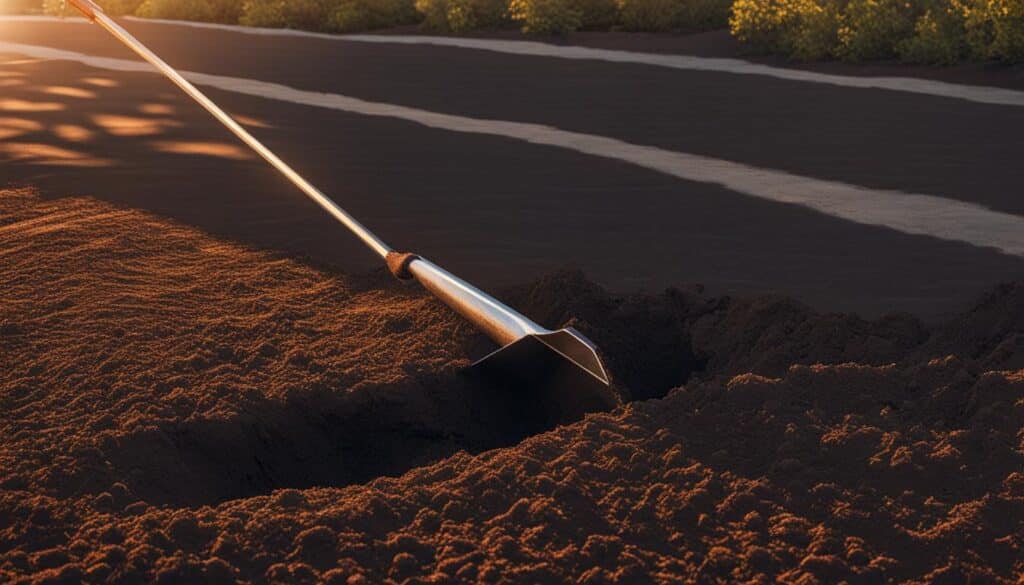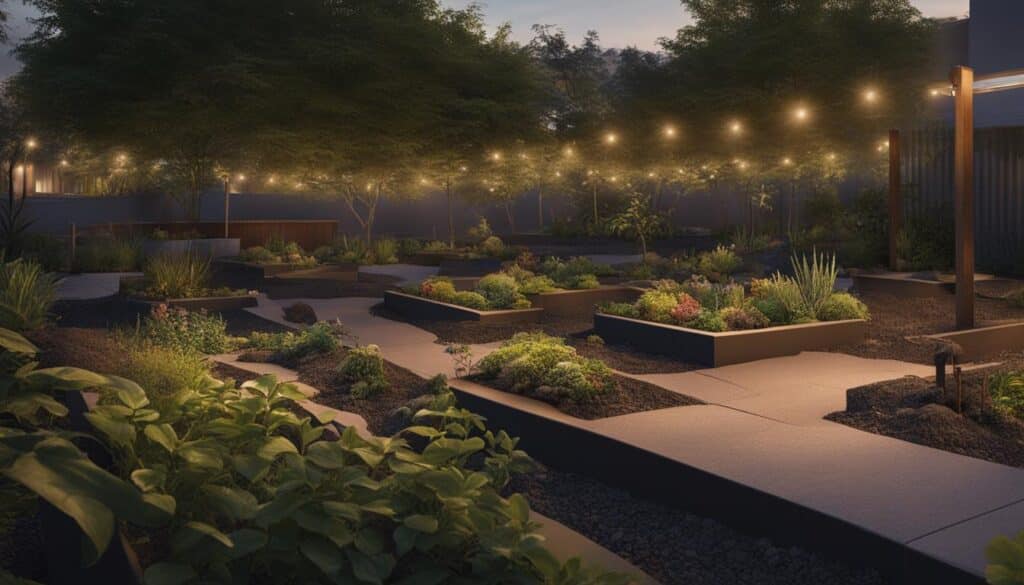When it comes to enhancing the beauty of outdoor spaces, landscape lighting is a game changer. As a DIY enthusiast or homeowner, it’s important to understand the nuances of how to bury landscape lighting wire safely and efficiently. The process of burying the wire is the final step after setting up your lighting system. It involves testing each light for consistent voltage using a digital voltage meter to prevent premature burnout and ensuring you make solid and long-lasting connections. Before burying, it’s essential to lay out everything, test your voltage, and verify the results at night.
Key Takeaways
- Planning the layout of your landscape lighting is crucial for efficient installation and appealing results.
- Test each light fixture’s voltage with a digital voltage meter before burying the landscape lighting wire.
- Leave extra wire when burying to accommodate future adjustments.
- Choose a transformer with a photocell and timer for automated lighting control.
- Invest in durable wire connectors for a strong and long-lasting connection.
- Consider special lights for unique lighting effects, such as moon lights.
Understanding the Basics of Landscape Lighting
Installing low voltage landscape lighting can turn your home exteriors into dazzling spaces while offering a multitude of benefits. An understanding of the basic elements involved in landscape lighting will help you create a beautiful and functional outdoor environment. Let’s explore the appeal of low voltage landscape lighting and the importance of proper landscape lighting wire installation.
The Appeal of Low Voltage Landscape Lighting
Low voltage lighting, typically ranging from 12 to 24 volts, is safer and more energy-efficient than high voltage options. Its popularity stems from the fact that it consumes less electricity while providing adequate illumination for your home’s exterior. Additionally, the low voltage allows for easy installation and flexibility in lighting design, opening up a world of possibilities for outdoor lighting systems. Embrace the allure of low voltage lighting for a radiant outdoor environment that grabs attention.
The Importance of Proper Landscape Lighting Wire Installation
It’s crucial to acknowledge the importance of correct installation, which warrants careful planning and precision. When it comes to burying wire for landscape lighting, a few key factors must be considered. Firstly, plan a layout that showcases your home’s features and ensures consistent illumination. Opt for durability in your wire connectors and always use quality landscape lighting wire designed for outdoor use. By adhering to best practices, you can create a stunning and reliable outdoor lighting system that enhances your home’s appeal.
As we delve deeper into the subject of landscape lighting, we’ll cover various aspects such as tools, layout planning, and maintaining your buried landscape lighting system. The goal is to equip you with the knowledge needed to create a beautiful, efficient, and long-lasting outdoor lighting setup that leaves a lasting impression.
Choosing the Right Tools for Burying Landscape Lighting Wire
To ensure a successful installation of landscape lighting wire, selecting the right tools is crucial. Investing in a reliable digital voltage meter and durable wire connectors can significantly improve the performance and lifespan of your lighting system.
Selecting a Quality Digital Voltage Meter
A dependable digital voltage meter is essential for testing each fixture’s voltage level, guaranteeing uniformity and longevity of your landscape lighting. Frequent voltage checks can help diagnose and fix potential issues before they cause any damage to your lighting system.

The Necessity of Durable Wire Connectors
When connecting landscape lighting wire, choosing robust and enduring wire connectors is vital to ensure your connections can withstand the elements. By cutting off press-on fittings and using solid wire connectors, you significantly increase the lifespan of your outdoor lighting system. A comparison of different wire connectors can be seen in the table below:
| Wire Connector Type | Pros | Cons |
|---|---|---|
| Silicone-filled Wire Connectors | Water-resistant, durable, easy to install | Can be slightly more expensive than other options |
| Twist-on Wire Connectors | Easy to install, low cost | Less weather-resistant, might require a weatherproof cover |
| Waterproof Wire Connectors | Weather-resistant, easy to install, low cost | Sometimes require periodic tightening/adjustment |
In summary, using the right tools like a quality digital voltage meter and durable wire connectors is paramount for the successful installation of your landscape lighting system. These tools not only ensure robust connections and proper functioning but also extend the life of your outdoor lighting investment.
Planning Your Landscape Lighting Layout
Designing your landscape lighting layout is about more than just aesthetics – it’s about functionality as well. By mapping out approximate light locations and considering their proximity to power sources, you can create an efficient system that delivers on both fronts. To help you get started, here’s a step-by-step guide on planning and designing your landscape lighting:
- Consider the availability of outdoor electrical outlets for the transformers. Make sure there are enough outlets to support your lighting needs without overloading the circuits.
- Plan your light arrangement to best showcase your home’s features. Think about which areas of your property should be highlighted and choose suitable lighting fixtures accordingly.
- Keep in mind that the layout can have implications on the overall illuminating effect. Evaluate your design at different times of the day and make adjustments as needed.
- Create a scaled drawing of your property, marking the location of each light fixture. This will help you visualize the overall design and make adjustments as necessary.
- Take into account any obstacles that might hinder the installation or affect the visibility of your lights, such as trees, bushes, or walls.
- Factor in the hiding of landscape lighting wire for a neat appearance. Tuck wires behind shrubs, under rocks, or use conduit to hide them along pathways.
Remember that planning is crucial to the success of your landscape lighting design. With a well-thought-out plan in place, you’ll be better prepared to tackle the installation process and achieve a beautiful, functional lighting system.
How to Bury Landscape Lighting Wire
When it comes to burying landscape lighting wire to create an efficient and beautiful outdoor lighting system, there are a few steps to follow. By testing fixture voltage, mapping out your lighting system, and avoiding voltage drop, you can ensure a reliable and enchanting landscape lighting experience.

Testing Fixture Voltage Before Burying
Prior to burying your landscape lighting wire, it’s essential to test each light fixture’s voltage to avoid inconsistencies or premature burnout of lamps. By doing this, you confirm that your burying low voltage lighting wire is providing stable power to the fixtures. A digital voltage meter is a valuable tool for accurate voltage measurements of your burying electric wire for landscape lighting.
Mapping Out Your Lighting System
Design your landscape lighting system layout by considering the position of fixtures and their proximity to power sources. Keep track of transformer locations and take extra wire into account for possible future adjustments. Examine lighting effects at night before burying the wires, ensuring your lighting system meets your desired goals. Proper planning will provide the foundation for a successful landscape lighting installation.
Avoiding Voltage Drop in Your Landscape Lighting
To prevent voltage drop and disarray in your landscape lighting system, create a “T” with the wiring along the cable path. This helps to reduce voltage drop and keeps the wattage under control, with no more than 100 watts on one line. Additionally, the orientation of photocells is crucial for automated lighting control. Aim for some western exposure to ensure an efficient and visually appealing landscape lighting setup.
Connecting the Landscape Lighting Wire
Properly connecting landscape lighting wire is a critical step toward a reliable and effective landscape lighting system. To ensure long-lasting functionality, it’s essential to use solid wire connectors rather than press-on fittings for more secure connections. Additionally, if you’re planning to include a substantial number of lights, consider making a tee connection to balance voltage across the system.
As you connect your landscape lighting wire, always think of future adjustments. Make careful connections and avoid rushing to bury the wires before thoroughly testing your setup at dusk. Performing a complete test before burying the wires will prevent the need for rework if any issues with the lighting system arise.
Following these guidelines, your landscape lighting system will come alive and beautifully showcase your outdoor spaces. The proper connection of your lighting system is key to achieving that desired magical effect, inviting you and your guests to enjoy the outdoors even after the sun has set.
Best Practices for Burying the Wire
Implementing the best methods to bury landscape lighting wire is crucial to protect your investment and ensure long-lasting, efficient performance of your lighting system. Focusing on the appropriate depth for burying wire and properly protecting it will result in a well-concealed and robust lighting system.

Ensuring the Appropriate Depth for Burying Wire
When burying landscape lighting wire, it is recommended to dig a thin, 6-inch trench along the cable path. This depth is typically sufficient to protect the wire from regular lawn maintenance while keeping it out of sight. Following these guidelines will ensure your wire remains safe from accidental damage due to gardening activities, heavy foot traffic, or water infiltration.
Protecting Burying Landscape Lighting Wire
Protecting your landscape lighting wire is paramount for maintaining a reliable system that will last for many years. Be sure that the cable runs smoothly through the trench without any sharp bends or kinks, as these can cause wire degradation over time. After placement in the trench, backfill the soil and lightly compact it to protect and conceal the wire. This creates an unobtrusive and tidy finish that not only enhances the appearance of your landscape but also preserves the durability of your outdoor lighting system.
In conclusion, using the best methods to bury landscape lighting wire, ensuring an appropriate depth for burying wire, and protecting your investment significantly impacts the performance and longevity of your outdoor lighting. By adhering to these best practices, you can create a vibrant, radiant outdoor space that’s built to withstand the test of time.
Special Considerations for Burying Outdoor Lighting Wire
When it comes to burying landscape lighting wire, certain situations demand special attention and care. Unique outdoor features or lighting styles may not fit the standard wire burying methods and instead require tailored approaches. In this section, we’ll look at some of the essential considerations for burying wire in unique outdoor settings.
Watertight fixtures, such as pond lights, pose a unique challenge due to their proximity to water. To keep the connections safe from moisture, bury them in the drier dirt at the edge of the pond. This helps keep electrical connections dry and reliable, ensuring the longevity of your special outdoor lighting.
For moon lighting installations, a stable base is essential to house wiring connections securely. Use durable materials like treated wood to construct a solid foundation and attach the wire to structures with appropriate clips. Furthermore, to achieve an authentic night-time experience, always simulate natural moon shadows by correctly positioning your moon lights.
Let’s recap some of the burying wire considerations for unique outdoor lighting setups:
- For watertight fixtures like pond lights, bury connections in the drier dirt away from the water source.
- Create a stable base for moon lighting installations to house connections securely.
- Secure wiring to structures using appropriate clips.
- Simulate natural moon shadows by correctly positioning moon lights.
By following these guidelines and accounting for any special considerations, you can create a stunning, safe, and reliable landscape lighting setup that accentuates your outdoor space’s unique features.
Maintaining Your Buried Landscape Lighting System
A well-functioning buried landscape lighting system can effortlessly enhance the aesthetic appeal and safety of your outdoor space. To ensure the longevity and reliability of your system, regular maintenance is crucial. This includes conducting consistent voltage checks, sealing outdoor connections, and periodically inspecting the overall setup. Keep in mind that diligent upkeep can save you from expensive repairs or replacements in the future.

Regular Voltage Checks to Prevent Burnout
Regular voltage checks are essential for preventing irregularities and burnout of halogen lights. A proper voltage check can identify potential issues with your system before they escalate, enabling you to address them promptly. Ensure all connections remain secure over time and perform any necessary adjustments on the transformer to maintain optimal performance.
Properly Sealing Outdoor Power Connections
It is vital to properly seal outdoor power connections against moisture and debris to prevent system failures and maintain safety. Use quality waterproof materials and methods to protect the wiring, and be sure to inspect the connections regularly. This proactive approach to sealing and shielding will help keep your landscape lighting system functioning efficiently and safely.
In conclusion, maintaining your buried landscape lighting system requires attention to detail and a commitment to regular upkeep. By adhering to best practices and conducting frequent inspections, you can ensure your outdoor lighting remains both striking and dependable for years to come.
Advanced Installation Techniques: Special Lights for Special Effects

For those looking to go beyond the basics, advanced installation techniques can be used to create unique lighting effects. By integrating special outdoor lights, such as moon lights, homeowners can simulate the effect of moonlight filtering through the trees. When planning for these special effects lighting, it’s crucial to consider the spacing and positioning to achieve the desired effect and create a captivating atmosphere in your outdoor space.
Use durable materials like treated lumber for installation bases and secure everything firmly to prevent movement. Ensuring your lighting continues to provide the intended ambiance is essential for a long-lasting, visually striking setup.
Proper planning and consideration of spacing and positioning can take your landscape lighting to the next level with special effects and unique illumination.
Let’s explore some popular special outdoor lights and their installation requirements:
- Moon Lights: These lights are installed at specific heights to cast shadows that mimic natural moonlight. Consider the height and direction of the light for a realistic effect.
- Color-Changing Lights: Create dynamic lighting effects by integrating color-changing lights into your landscape. Consider their placement and color patterns when planning your installation.
- Submersible Pond Lights: Enhance water features by adding submersible pond lights. Make sure to use waterproof connections and housings to protect the electrical components.
By incorporating these advanced installation techniques and special outdoor lights into your landscape lighting design, you can elevate your outdoor space and create an extraordinary lighting experience.
| Light Type | Installation Requirements | Tips and Considerations |
|---|---|---|
| Moon Lights | Install at specific heights and angles | Consider the height and direction of the light for a realistic effect. |
| Color-Changing Lights | Strategic placement and color patterns | Experiment with various color transitions and patterns to create dynamic effects. |
| Submersible Pond Lights | Waterproof connections and housings | Ensure proper waterproofing and follow safety guidelines for wiring near water features. |
Conclusion
In conclusion, burying landscape lighting wire can transform your outdoor space into a beautifully lit haven. Reviewing the steps for successful installation, it is clear that careful planning, using the right tools, and adhering to installation best practices are paramount. Incorporating these elements will not only result in an enchanting atmosphere, but a landscape lighting installation that withstands the test of time.
Reviewing the Steps for Successful Wire Burying
From testing for voltage consistency to burying the wire at the appropriate depth, each step plays a critical role in ensuring your landscape lighting lasts for years to come. Remember to use quality wire connectors, a reliable digital voltage meter, and bury the wire properly by digging a 6-inch trench for a tidy, unobtrusive look.
Exploring Future Landscape Lighting Enhancements
As you look forward to future enhancements and advanced installation techniques, such as special effects lighting for unique ambience, always bear in mind that maintenance is key. Ensuring your connections remain sealed against moisture and debris, as well as conducting periodic voltage checks, can help preserve the enchanting atmosphere of your landscape lighting, making every outdoor experience enjoyable and magical.
FAQ
What are the benefits of low voltage landscape lighting?
Low voltage landscape lighting, typically ranging from 12 to 24 volts, is safer and more energy-efficient than high voltage options. It can help transform your outdoor spaces into beautiful, well-lit areas while being a cost-effective solution for homeowners.
What tools are necessary for burying landscape lighting wire?
A reliable digital voltage meter is indispensable for testing each fixture’s voltage level, ensuring uniformity and longevity. It’s also vital to choose wire connectors that provide robust, enduring connections to withstand the elements.
How do I plan my landscape lighting layout?
When planning your landscape lighting layout, consider the proximity to power sources and the positioning of lights to best showcase your home’s features. Keep in mind the layout can have implications on the overall illuminating effect, so make adjustments accordingly.
What should I consider before burying landscape lighting wire?
Before burying landscape lighting wire, test each light for proper voltage to avoid inconsistencies or premature burnout. Create a ‘T’ with the wiring to reduce voltage drop, and consider leaving extra wire for future adjustments. Check the effect at night before burial to ensure satisfactory results.
How should I connect my landscape lighting wire?
Use solid wire connectors rather than press-on fittings for more secure connections. Consider making a tee connection if you’re planning a substantial number of lights to balance voltage across the system. Don’t rush to bury the wires; thoroughly test your setup at dusk before proceeding.
What is the best method to bury landscape lighting wire?
Dig a thin, 6-inch trench along the cable path, ensuring that the wire runs smoothly without any sharp bends or kinks. After placing the wire in the trench, backfill the soil and lightly compact it to protect and conceal the wire, ensuring an unobtrusive and tidy finish.
Are there any special considerations for burying wire in specific areas?
For watertight fixtures like pond lights, bury connections in the drier dirt at the edge of the pond. For moon lighting, create a base to house connections securely. Always secure your wire to structures using appropriate clips and make sure to position your moonlights correctly for a natural effect.
How do I maintain my buried landscape lighting system?
Regular voltage checks are essential to prevent irregularities or burnout of halogen lights. Ensure all connections remain secure over time, perform any necessary adjustments on the transformer, and properly seal outdoor power connections against moisture and debris to maintain safety and prevent system failures.
What advanced installation techniques can be used to create unique lighting effects?
Install special lights like moonlights at specific heights to cast shadows, simulating the effect of moonlight filtering through the trees. Consider spacing and positioning to achieve the desired effect. Use durable materials like treated lumber for installation bases, and secure everything firmly to prevent movement.

